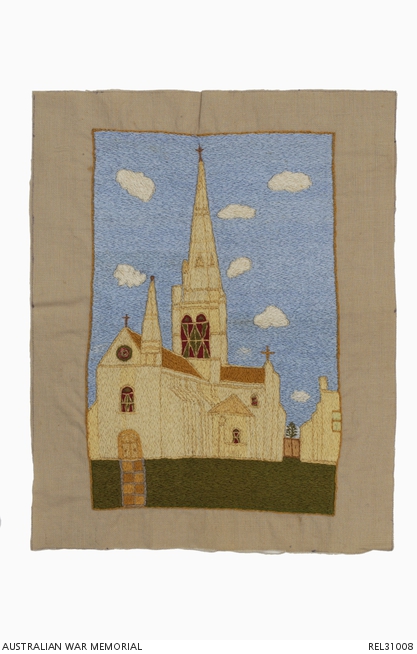Stitches in time: rehabilitation embroidery in the AWM collection
Many people tend to associate embroidery and needlework with women and the comfort of the homefront, but men are also known to pick up the needle and thread, especially it seems during times of war. Whether stitched as a way to pass the time in a prisoner of war camp, to record events, places and names, or as rehabilitation therapy in military hospitals, embroidered items have many interesting stories to share. To celebrate World Embroidery Day, 30 July, here are some examples of First World War rehabilitation embroidery from the Memorial’s National Collection, and stories of the men who made them. Many more can be found by searching our collection database – http://www.awm.gov.au/advanced-search
* * *
Private Stanley Chivas
Rehabilitation embroidery : Private S A Chivas, 14 Machine Gun Company, AIF
18 year old Stanley Chivas, who had recently emigrated to Australia from Scotland, enlisted with the Australian Naval and Military Expeditionary Force in December 1914 but was discharged at his father's request on 11 May 1915 as he was underage. Chivas then enlisted in the Australian Imperial Force on 3 July 1915 and sailed from Sydney aboard HMAT Runic on 9 August. He joined 2 Battalion on the Gallipoli Peninsula on 31 October. Six days later Chivas received a bullet wound to his left thigh and was evacuated by hospital ship to Egypt for treatment. After his recovery he transferred to 54 Battalion in February 1916, and then to 14 Machine Gun Company in March. He proceeded to France in July.
Chivas was again wounded in action on 10 August 1918. Shortly after his recovery, Chivas was wounded for the third time on 1 September, receiving severe gunshot wounds to his right arm, leg and buttock. He was invalided to the United Kingdom for treatment and during his rehabilitation made this embroidery as part of his occupational therapy programme. Stitching in longstitch and stemstitch, Chivas personalised the Rising Sun general service badge design by incorporating the name of his unit '14TH M.G.C. MG' into the embroidery below the crown. Chivas married Alice Edward Collie in Scotland in January 1919 before returning to Australia aboard SS Orontes in May, and was discharged on 30 August 1919.
Private Albert Biggs
Rehabilitation embroidery : Lance Corporal Alfred Briggs (Albert Biggs), 20 Battalion, AIF
Born in Sydney in 1892, Albert Biggs was working as a labourer when he enlisted in the AIF on 29 May 1915, using the alias Alfred Briggs. After initial training, Biggs was assigned to the 2nd reinforcements for 20 Battalion. He left Sydney for overseas service on 19 June, aboard HMAT A61 Kanowna. The battalion trained briefly in Egypt before arriving at Gallipoli in late August, where they defended Russell's Top until they were evacuated to Egypt in December.
The battalion moved to France for service on the Western Front in April 1916. Biggs sustained a gunshot wound to his left leg during the battalion's first major action at Pozieres on 5 August, and was evacuated to the 3rd London General Hospital. Two months later Biggs was discharged to the 5th Training Battalion, where he remained until he rejoined the 20th Battalion in France on 19 February 1917. He was promoted to lance corporal on 23 March. On 15 April, Biggs was awarded the Military Medal for 'great initiative and bravery', at Lagnicourt.
Biggs was severely wounded during the second battle of Bullecourt, on 5 May, sustaining a penetrating shrapnel wound to his left knee and a severe fracture of the humerus, just above his right elbow. He was evacuated to 6 Field Ambulance, then to a casualty clearing station, and finally to the 1st Australian General Hospital at Rouen, where he remained until the end of April 1918. On 29 April he was transferred to England, to the Tooting Military Hospital in London. In July, Biggs was sent to 1 Australian Auxiliary Hospital at Harefield to prepare him for his return to Sydney in September. He spent nearly two years at the 4th Australian General Hospital (4 AGH) at Randwick, and convalescent homes, before his discharge from the army on 7 July 1920.
Biggs’ wounds permanently fused his left knee, and so damaged the nerves in his right arm that he had very little function in that hand. He was encouraged to take up embroidery as a means of both passing the time and of 'training' his left hand in fine motor skills. This example, embroidered in stem, long and satin stitch, is thought to have been completed while he was at 4 AGH.
Towards the end of his life Biggs lived with his niece, Emily, and her husband Fred Lees. She made three of her uncle's rehabilitation embroideries into cushions, which were always positioned on her living room sofa until they were donated to the War Memorial.
Private William Hilton
These long, stem and herringbone stitch embroideries, with French knots, were stitched by Private William Hilton. He enlisted on 17 August 1915 and served on the Western Front with 19 Battalion. During his service Private Hilton spent some time in a French hospital recovering from a severe case of trench foot and was taught to embroider these scenes as part of his rehabilitation. Unlike the more ‘patriotic’ designs stitched by Chivas and Biggs (the rising sun and coat of arms), Hilton embroidered scenes of rural French life and local architecture. He embarked for return to Australia on 24 May 1918.
* * *
Inspired by the handiwork of these men, I have taken up needle and thread and tried my hand at stitching an embroidery based on the Rising Sun design of one of the First World War patriotic patterns. I will post another blog soon to detail my endeavours and reveal the result.



